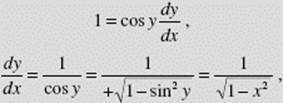Calculus AB and Calculus BC
CHAPTER 3 Differentiation
G. IMPLICIT DIFFERENTIATION
When a functional relationship between x and y is defined by an equation of the form F(x, y) = 0, we say that the equation defines y implicitly as a function of x. Some examples are x2 + y2 − 9 = 0, y2 − 4x = 0, and cos (xy) = y2 − 5 (which can be written as cos (xy) − y2 + 5 = 0). Sometimes two (or more) explicit functions are defined by F(x, y) = 0. For example, x2 + y2 − 9 = 0 defines the two functions ![]() the upper and lower halves, respectively, of the circle centered at the origin with radius 3. Each function is differentiable except at the points where x = 3 and x = −3.
the upper and lower halves, respectively, of the circle centered at the origin with radius 3. Each function is differentiable except at the points where x = 3 and x = −3.
Implicit differentiation is the technique we use to find a derivative when y is not defined explicitly in terms of x but is differentiable.
In the following examples, we differentiate both sides with respect to x, using appropriate formulas, and then solve for ![]()
EXAMPLE 27
If x2 + y2 − 9 = 0, then
![]()
Note that the derivative above holds for every point on the circle, and exists for all y different from 0 (where the tangents to the circle are vertical).
EXAMPLE 28
If x2 − 2xy + 3y2 = 2, find ![]()
SOLUTION: 
EXAMPLE 29
If x sin y = cos (x + y), find ![]()
SOLUTION: 
EXAMPLE 30
Find ![]() using implicit differentiation on the equation x2 + y2 = 1.
using implicit differentiation on the equation x2 + y2 = 1.
SOLUTION: ![]()
Then

where we substituted for ![]() from (1) in (2), then used the given equation to simplify in (3).
from (1) in (2), then used the given equation to simplify in (3).
EXAMPLE 31
Using implicit differentiation, verify the formula for the derivative of the inverse sine function, y = sin−1 x = arcsin x, with domain [−1,1] and range ![]()
SOLUTION: y = sin−1 x ↔ x = sin y.
Now we differentiate with respect to x:

where we chose the positive sign for cos y since cos y is nonnegative if ![]() Note that this derivative exists only if −1 < x < 1.
Note that this derivative exists only if −1 < x < 1.